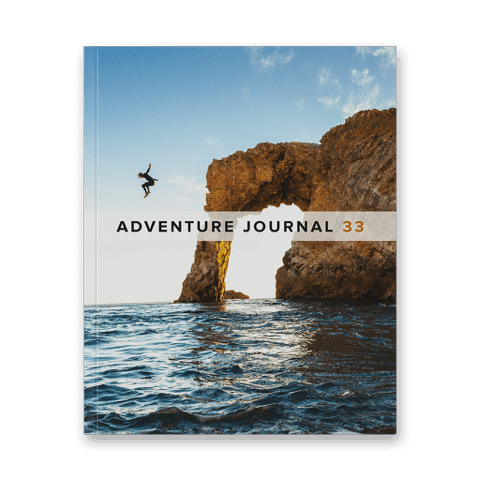Image credit: adventure-journal
Stephen Casimiro, a former editor of Powder and National Geographic Adventure, is the founder and publisher of Adventure Journal, an unapologetically analog magazine at the heart of an old-school trend.
He sifted through the pages. He smiled and said:
“People will have this in their hands, on their coffee table. That was the idea. We’re all exhausted from our screens. We want something to savor.”
There are sprouts of life, even profitability, on the landscape of print media and magazines, cratered by the pixilated bombardment of the digital age. High-end niche periodicals are popping up, but the trend might be most evident in a burst of small-batch, independent outdoors magazines like Adventure Journal, Mountain Gazette, Summit Journal and Ori. They are crowding into quiet spaces of narrow lanes — climbing, surfing, skiing, running and the like — where quality is key, advertising is minimal and subscribers are faithful. Most do not put their content online; this is journalism meant to be thumbed through, not swiped past.
The magazines are sometimes oversized and increasingly matte finished, filled with edge-to-edge photographs and literary heaves. They can cost $25 or more per issue. They are meant as much for the coffee table as the shoulder bag — designed to be collectible, not disposable.
Like vinyl records and micro beers, they’re aimed at a small audience with appreciation for the craft. Most are at-home operations where the editors are owners, managing a web of freelancers and overseeing every bit of the production cycle. Like Casimiro, many are expats from the wreckage of iconic glossy magazines that lost luster in an era of consolidation, venture capitalism and attention spans deemed too short to consume anything but algorithmic candy.
In Seattle, Ori founder Kade Krichko called it the “slow-read movement.” Near Lake Tahoe, Mountain Gazette owner Mike Rogge believes “we went too far in the digital realm — and now we’re pulling it back.” In New York, writer and climber Michael Levy has resurrected Summit (calling it Summit Journal), seeing a desire for curation.
“There’s a lot of really good stuff in the outside ecosystem, but it gets drowned out by the noise,” Levy said. “I have no interest in just trying to churn out content.”
Back in California, where he began publishing the quarterly Adventure Journal in 2016, Casimiro, 62, considered the wave of titles that have followed his lead, mostly since 2020. “Outdoor boutique magazines are having a moment,” he said.
The Surfer’s Journal persists as envisioned, now with about 28,000 subscribers (six issues a year for $84, or $25 for one) and eight “sponsors” (each paying $70,000 per year). Thousands of other copies are sold in surf shops and bookstores. The company has expanded into books, a popular podcast and The Golfer’s Journal, with manicured green grass taking the place of swelling blue oceans. It has about two dozen employees, including those who handle circulation from company headquarters.
Debbee Pezman, now 69 and The Surfer Journal’s publisher (Steve retired in 2015), thought about the secret ingredients to success, then typed them into a one-page memo. Among them:
“Never underestimate the intelligence of the reader.”
She does not call it a magazine, but a journal, even a bimonthly book. She noted high-end flourishes, like an embossed title. She picked up an upcoming issue, printed on thicker paper — 18 percent thicker. Why do that?
“That’s a really good question, because it’s going to cost, like, $22,000 in postage,” Pezman said. But she sees other magazines entering the market, ratcheting up the standards that she helped set. “It’s just a dial-up of our quality, to differentiate,” she said.
What readers want, she believes, is not rooted in nostalgia for print. It is based on things like posture and pulse rate.
High-end magazines are not new, and their re-emergence is not exclusive to outdoor pursuits. A visit to an independent bookstore or a sprawling newsstand like Casa Magazines in New York or The Kosher News in Los Angeles unveils a universe of artful niche publications, from The Bitter Southerner to Catnip, Mildew to Whalebone.
The surge is acute in American outdoor magazines, where esteemed mass-market titles like Outside, National Geographic, even Sports Illustrated — along with a bevy of once-loved, deep-niche outdoor titles covering everything from climbing to skiing, running to biking, snowboarding to skateboarding — have struggled to paddle through the fire hose of online content.
“Nobody’s doing it for the money,” Casimiro said. “I mean, we’re doing it because we need to make a living, but we’re doing it because we’re so passionate about it.”
Persistent worries include the cost of print production, which spiked during the pandemic and have not receded, and the relatively small group of outdoor-industry advertisers. Another 4,000 subscribers would allow Adventure Journal to eliminate advertising, making it completely financed by readers, Casimiro said.
Four times a year, from a computer screen, Casimiro sends the pages of his latest issue — not instantly to readers, who have to wait a few weeks by their mailboxes, but to an old-fashioned printing company in Orange County.
Once the pages are printed, they are trucked to a nearby bindery and fed into a whirring machine of conveyors, choppers and hot glue. They emerge at the other end, like a wonder from another time, but also a future response to today.
Even after decades in the magazine business, Casimiro finds delight in it all.
Navkiran Dhaliwal is a seasoned content writer with 10+ years of experience. When she's not writing, she can be found cooking up a storm or spending time with her dog, Rain.


